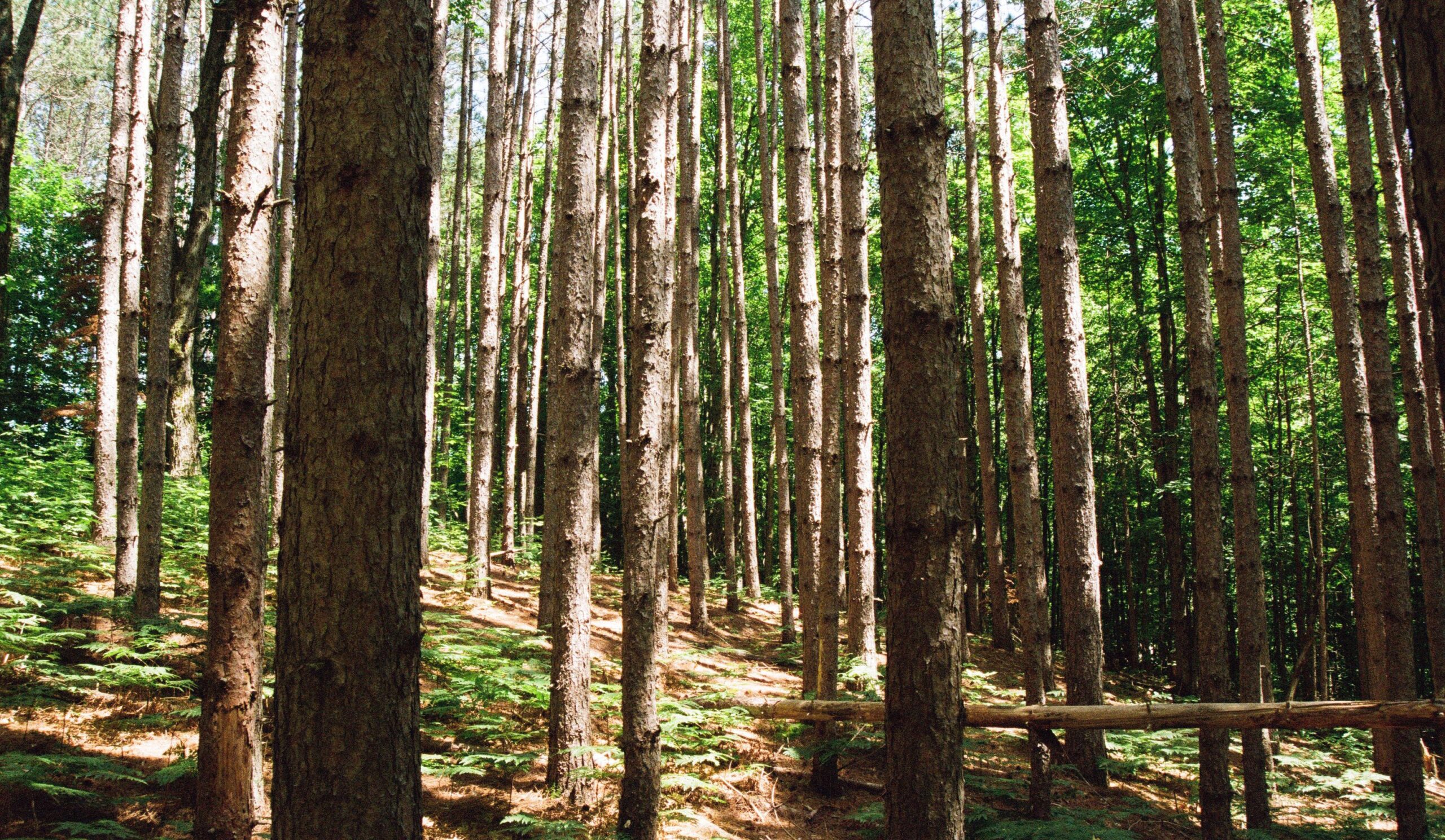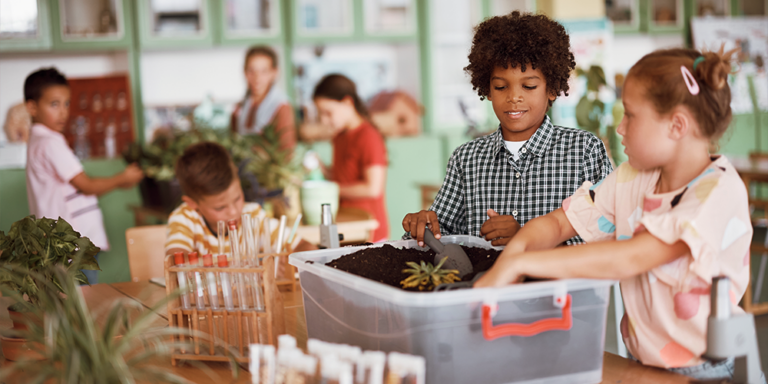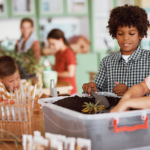A couple of years ago, the FIRST LEGO League(Open Link in new tab) robotics theme was “Trash Trek(Open Link in new tab).” That was the year that I decided to coach not one, but two teams of middle school students… by myself. After thinking long and hard about the challenge topic, the teams came up with two original solutions.
Team 1 joined efforts with a local trash company to recycle lunchroom milk cartons.
Team 2 had read that mealworm larva could eat styrofoam. They decided to grow mealworms, measure their consumption, and develop a plan for landfills. They grew mealworms in my classroom for six months. Did you know those little buggers grow wings? I didn’t.

As Earth Day is quickly approaching, I’ve been thinking a lot about that robotics season and the initiative of those amazing students. They were motivated to make a change. They were obsessed with their efforts and even wrote songs about mealworms to quell the fears of the local elementary students — highlighting that while the worms could eat trash, they wouldn’t actually eat their house.
FIRST was a great way to get my students engaged, but how can we elicit engagement in our classrooms and help students become stewards of the earth year round?
I was reminded that my students can and will do anything they set their minds to, but they need to have a reason.
Reason, Rallies, and Response
Earth Day started with a reason. While many associate Earth Day with after-school specials and Captain Planet(Open Link in new tab), according to earthday.org(Open Link in new tab), Earth Day actually began with civic engagement and a movement(Open Link in new tab) in the 1970s.
Rachel Carson’s New York Times bestseller, Silent Spring(Open Link in new tab), was published in 1962, bringing to light the impact of chemicals on the environment. Meanwhile, the Vietnam war raged on and on, and in 1969, after witnessing the impact of a massive oil spill(Open Link in new tab) in Santa Barbara, California, two congressmen — Sen. Gaylord Nelson (D), and Rep. Pete McCloskey (R) — and Harvard Law School student Denis Hayes, joined forces in a bipartisan effort to organize a national “Teach-in” for the environment(Open Link in new tab).
As people heard news of the event, they started to take action. And as a result of that first Earth Day(Open Link in new tab), the United States government created the Environmental Protection Agency(Open Link in new tab) and passed the Clean Air,(Open Link in new tab) Clean Water(Open Link in new tab), and Endangered Species(Open Link in new tab) Acts.
Generation Y and iGen = Generation Why? and iCan!
As educators, we’re seeing our students more motivated to make a difference than ever before. As we prepare to celebrate Earth Day in our classrooms this spring, why not focus on empowering students to make #EveryDayEarthDay(Open Link in new tab), while creating meaningful inquiry experiences and phenomena-based investigations?
Questioning
We’re surrounded by natural beauty and captivating experiences. For inspiration, visit Phenomena for NGSS(Open Link in new tab), or have students bring in photographs of their favorite vacation spots. Use these images as the basis for asking questions about the differences in ecosystems, environments, and our world.
Make Science Relevant with Current Events
Have students pay attention to what events in the news are impacting the environment and practice making science relevant with current events(Open Link in new tab).
Culturally Relevant STEM Instruction
Pay heed to cultural relevance and relationships students have with the Earth. Check out the tools from STEM Teaching Tools (Open Link in new tab)for inspiration. My favorite tools in this set are:
- Practice Brief 11: Implementing Meaningful STEM Education with Indigenous Students & Families(Open Link in new tab)
- Practice Brief 12: Scientific Literacy Involves Understanding Global Climate Change & What People Can Do About It(Open Link in new tab)
- Practice Brief 20: Getting Their Hands Dirty: Engaging Learners in Authentic Science Practices Outside the Classroom(Open Link in new tab)
- Practice Brief 53: How to Avoid Known Pitfalls Associated with Culturally Responsive Instruction(Open Link in new tab)
Keep it Local
Embrace your local environment as a catalyst for investigations and sense-making. For example, check out Tch NGSS Squadster(Open Link in new tab) Olu Banmeke’s #tchNGSS(Open Link in new tab) Squad in Action video on using his local State of the Bay Report(Open Link in new tab).
The 2016 State of the Bay Report as a fitting phenomenon(a) for NGSS Standards:ESS3C (Human Impacts on EarthSystems);LS4D Biodiversity & Humans; ETS 1B (Developing Possible Solutions). https://t.co/IiFOH3Obbw(Open Link in new tab) @TeachingChannel(Open Link in new tab) #highschool(Open Link in new tab) #newkindofpd(Open Link in new tab) #ngss(Open Link in new tab)https://t.co/9Y3QfS4BFW(Open Link in new tab)
— Olu Banmeke (@kaybanms) February 26, 2018(Open Link in new tab)
Looking for other storylines and activities? Visit Teaching Channel collaborator Jessica Levine’s blog(Open Link in new tab), celebrate with the Project Earth Game(Open Link in new tab), or try any of the activities from the Environmental Protection Agency(Open Link in new tab).
While mealworms were not my cup of tea, meaningful experiences for my students are worth going above and beyond what’s expected. We have one Earth and one opportunity to engage our students in a way that empowers them with the confidence to make a difference. If we continue to keep the Earth’s well being in mind as we plan instruction, then we can truly make it Earth Day, every day.
Follow the trend on Twitter with #EarthDayEveryDay(Open Link in new tab) and share what your students are up to this April 22nd. Already planning? Share your ideas in the comments below. We’d love to be inspired by YOU!
Looking to get support and resources from the Tch NGSS Squad?
Connect with us by visiting our Deep Dive(Open Link in new tab) or by engaging with other blog posts(Open Link in new tab) from our Next Gen Science Squadsters. And keep an eye out for our “Squad in Action” videos on Twitter at #TchNGSS(Open Link in new tab) and #anewkindofpd(Open Link in new tab).







